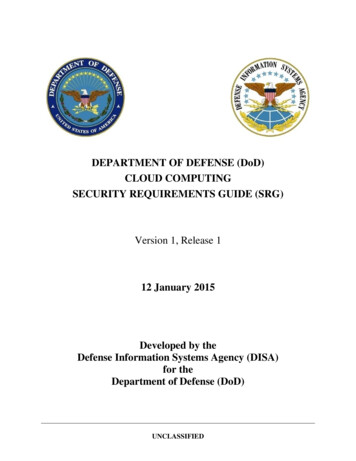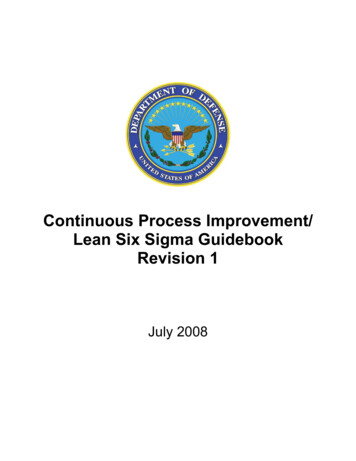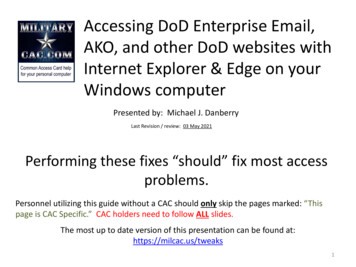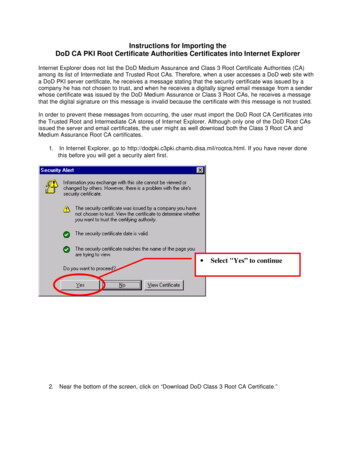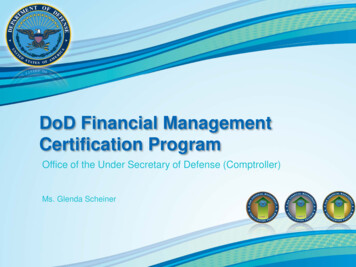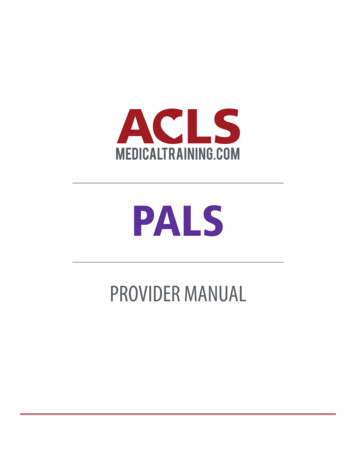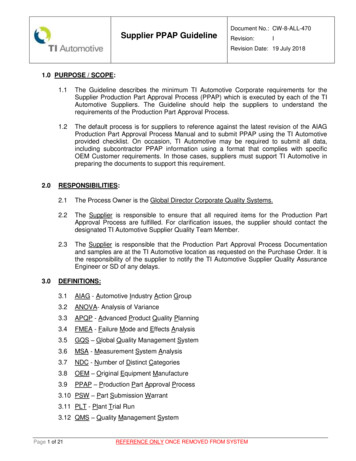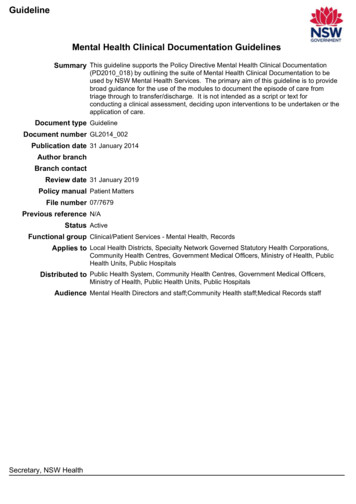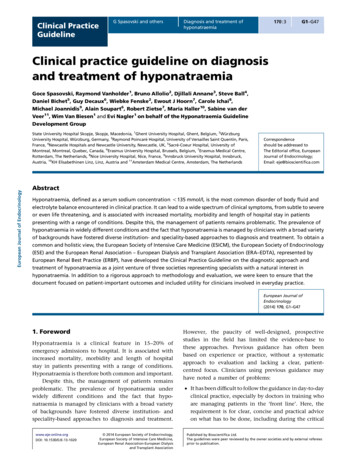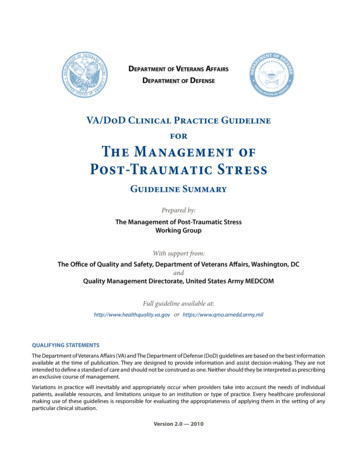
Transcription
Department of Veterans AffairsDepartment of DefenseVA/DoD Clinical Practice GuidelineforThe Management ofPost-Traumatic StressGuideline SummaryPrepared by:The Management of Post-Traumatic StressWorking GroupWith support from:The Office of Quality and Safety, Department of Veterans Affairs, Washington, DCandQuality Management Directorate, United States Army MEDCOMFull guideline available at:http://www.healthquality.va.govor https://www.qmo.amedd.army.milQUALIFYING STATEMENTSThe Department of Veterans Affairs (VA) and The Department of Defense (DoD) guidelines are based on the best informationavailable at the time of publication. They are designed to provide information and assist decision-making. They are notintended to define a standard of care and should not be construed as one. Neither should they be interpreted as prescribingan exclusive course of management.Variations in practice will inevitably and appropriately occur when providers take into account the needs of individualpatients, available resources, and limitations unique to an institution or type of practice. Every healthcare professionalmaking use of these guidelines is responsible for evaluating the appropriateness of applying them in the setting of anyparticular clinical situation.Version 2.0 — 2010
Table of ContentsINTRODUCTION. 3Core Module: Initial Evaluation and Triage.13Module A: Acute Stress Reaction and Prevention of PTSD.16Module B: management of PTSD.28Module I: Interventions.41Acronym List.542 Guideline Summary – 2010
IntroductionThis 2010 VA/DoD Post-Traumatic Stress Guideline Update builds on the VA/DoD Clinical Practice Guideline forthe Management of Post-Traumatic Stress published in 2004. The goal of this update is to integrate the results ofrecent research and update the recommendations of the original guideline to reflect the current knowledge ofeffective treatment interventions.Target Population:This guideline applies to adult patients with traumatic stress reaction treated in any VA or DoD clinical setting.Audiences:The guideline is relevant to all health care professionals providing or directing treatment services to patientswith post-traumatic stress at any VA/DoD health care setting.The Working Group developed a list of questions that focused on the main issues of the guideline. Anextensive literature search of relevant studies has been conducted and selected studies that met inclusioncriteria have been reviewed. The group had three face-to-face meetings and a series of conference calls inwhich the evidence was reviewed and specific recommendations were discussed.Review of Literature and Evidence:Recommendations for the performance or inclusion of specific procedures or services in this guideline werederived through a rigorous methodological approach that included the following: Determining appropriate criteria, such as effectiveness, efficacy, population benefit, and patientsatisfaction Performing a comprehensive literature search and selection of relevant studies from January 2002 toAugust 2009 to identify the best available evidence and ensure maximum coverage of studies at thetop of the hierarchy of study types Reviewing the selected studies to determine the strength of the evidence in relation to these criteria Formulating the recommendations and grading the level of evidence supporting eachrecommendationThis 2010 update builds on the 2004 version of the guideline and incorporates information from the followingexisting evidence-based guidelines/reports identified by the Working Group as appropriateseed documents: International Society for Traumatic Stress Studies. (2009). Effective treatments for PTSD: Practiceguidelines from the International Society for Traumatic Stress Studies. Foa, E.B., Keane, T.M., Friedman,M.J., & Cohen, J. (Eds). New York: Guilford Press. Institute of Medicine. (2007). Treatment of post-traumatic stress disorder: An assessment of the evidence.Washington, DC: The National Academies Press. American Psychological Association. (2009). Guideline watch (March 2009): Practice guideline for thetreatment of patients with acute stress disorder and posttraumatic stress disorder. Washington, DC:American Psychological Association.Management of Post-Traumatic Stress INTRODUCTION 3
Literature searches were conducted, covering the period from January 2002 through August 2009, thatcombined terms for post-traumatic stress, acute stress reaction (ASR), acute stress disorder (ASD), acute posttraumatic stress disorder, and chronic post-traumatic stress disorder. Electronic searches were supplementedby reference lists, and additional citations were suggested by experts. The identified and selected studies onthose issues were critically analyzed, and the evidence was graded using a standardized format, based on thesystem used by the U.S. Preventive Services Task Force (USPSTF, 2007).If evidence exists, the discussion following the recommendations for each annotation includes an evidencetable identifying the studies that have been considered, the quality of the evidence, and the rating of thestrength of the recommendation [SR]. The Strength of Recommendation, based on the level of the evidenceand graded using the USPSTF rating system (see Table: Evidence Rating System), is presented in bracketsfollowing each guideline recommendation.Evidence Rating SystemStrength of Recommendation (SR)AA strong recommendation that clinicians provide the intervention to eligible patients.Good evidence was found that the intervention improves important healthoutcomes and concludes that benefits substantially outweigh harm.BA recommendation that clinicians provide (the service) to eligible patients.At least fair evidence was found that the intervention improves health outcomes and concludes that benefitsoutweigh harm.CNo recommendation for or against the routine provision of the intervention is made.At least fair evidence was found that the intervention can improve health outcomes, but concludesthat the balance of benefits and harms is too close to justify a general recommendation.DA recommendation is made against routinely providing the intervention to asymptomatic patients.At least fair evidence was found that the intervention is ineffective or that harms outweigh benefits.IThe conclusion is that the evidence is insufficient to recommend for or against routinely providingthe intervention.Evidence that the intervention is effective is lacking, or poor quality, or conflicting, and the balanceof benefits and harms cannot be determined.*SR Strength of RecommendationWhere existing literature was ambiguous or conflicting, or where scientific data were lacking on an issue,recommendations were based on the clinical experience of the members of the Working Group.Post-Traumatic Stress:Post-traumatic stress consists of a spectrum of traumatic stress disorders—hence, this Clinical PracticeGuideline for the Management of Post-Traumatic Stress. These disorders can be arranged along a temporalaxis, from Acute Stress Reaction, to Acute Stress Disorder, Acute PTSD, and Chronic PTSD. Each of these may beassociated with serious mental and physical co-morbidities. Some survivors will experience only a part of thisspectrum, while others will progress through the entire range.Acute Stress Reaction (ASR) is not a DSM IV diagnosis and is used in this guideline to refer to a range oftransient conditions that develop in response to a traumatic event. Onset of at least some signs and symptomsmay be simultaneous with the trauma itself or within minutes of the traumatic event and may follow thetrauma after an interval of hours or days. In most cases symptoms will disappear within days (even hours).4 Guideline Summary – 2010
Combat and Operational Stress Reaction (COSR) reflects acute reactions to a high-stress or combat-relatedevent. ASR/COSR can present with a broad group of physical, mental, and emotional symptoms and signs(e.g., depression, fatigue, anxiety, decreased concentration/memory, hyperarousal, and others) that have notresolved within 4 days after the event, and after other disorders have been ruled out.Acute Stress Disorder (ASD), a diagnosis defined by DSM IV, occurs when the individual has experiencedtrauma(s) as described above, has symptoms lasting more than two days, but less than one month afterexposure to the trauma (may progress to PTSD if symptoms last one month), and exhibits re-experiencing,avoidance, increased arousal, and at least three out of five dissociative symptoms.Post-Traumatic Stress Disorder (PTSD) is a clinically significant condition with symptoms continuingmore than 1 month after exposure to a trauma that has caused significant distress or impairment in social,occupational, or other important areas of functioning. Patients with PTSD may exhibit persistent reexperiencing of the traumatic event(s), persistent avoidance of stimuli associated with the trauma, numbingof general responsiveness (not present before the trauma), and persistent symptoms of increased arousal (notpresent before the trauma). PTSD can also have a delayed onset, which is described as a clinically significantpresentation of symptoms (causing significant distress or impairment in social, occupational, or otherimportant areas of functioning) at least 6 months after exposure to trauma.PTSD is further sub-divided into Acute PTSD (symptoms lasting more than one month, but less thanthree months after exposure to trauma) and Chronic PTSD (symptoms lasting more than three monthsafter exposure to trauma). PTSD can appear alone (presenting with common symptoms of PTSD) or morecommonly with other co-occurring conditions (persistent difficulties in interpersonal relations, mood, chronicpain, sleep disturbances, somatization, and profound identity problems) or psychiatric disorders (meetingDSM criteria for another disorder, such as substance abuse, depression, and anxiety disorder).Recent research has shown that PTSD is highly prevalent among soldiers returning from combat duty. OEF/OIF/OND Veterans and Service Members who have sustained a concussion/mild traumatic brain injury(mTBI) in the combat environment are often at significantly greater risk of PTSD. Moreover, the diagnosis ofeither condition may be complicated by the fact that PTSD is associated with generalized health symptoms,including neurocognitive impairment and other symptoms in the persistent post-concussion syndromedefinition.Evidence-based practices to prevent and treat PTSD include screening, cognitive behavioral therapies, andmedications. There are many new strategies involving enhancement of cognitive fitness and psychologicalresilience to reduce the detrimental impact of trauma. In terms of screening, evidence suggests thatidentifying PTSD early and quickly referring people to treatment can shorten their suffering and lessen theseverity of their functional impairment. Several types of cognitive behavioral therapies, counseling, andmedications have been shown to be effective in treating PTSD.The VA and DoD health care systems have undergone significant changes in the past 10-15 years that aretransforming the two into an integrated system that provides high-quality care. In response to the increaseddemands for services to treat OEF/OIF/OND Service Members and Veterans with PTSD, these systemshave invested resources in expanding outreach activities, and enhancing the availability and timeliness ofspecialized PTSD services.Management of Post-Traumatic Stress INTRODUCTION 5
Guideline Update Working GroupDepartment of Veterans AffairsDepartment of DefenseRon Acierno, PhDCurtis Aberle, NPKathleen Chard, PhDDaniella David, MDMatt Friedman, MD (Co-Chair)Matt Jeffreys, MDLT Justin Campbell, PhDMAJ Debra Dandridge, PharmDCOL Charles Engel, MDCapt Joel Foster, PhDTerry Keane, PhDHarold Kudler, MDTodd Semla, PharmDSheila Rauch, PhDJosef Ruzek, PhD (Co-Chair)Steve Southwick, MDMurray Stein, MDCDR Stella Hayes, MDCharles Hoge, MDMAJ Kenneth Hyde, PACAPT Robert Koffman, MDCOL James Liffrig, MDCOL Patrick Lowry, MD (Co-Chair)LTC Sandra McNaughton, NPDavid Orman, MDReviewers and Contributors:Nancy Bernardy, PhDLTC Edward Brusher, LCSWMichael Clark, PhDBarbara Hermann, PhDBruce Capehart, MD, MBAKent Drescher, PhDCarolyn Green, PhDJulia Hoffman, Psy.DDan Kivlahan, PhDEric Kuhn, PhDWalter Penk, PhDPaula Schnurr, PhDJames Spira, PhD, MPHJennifer Vasterling, PhDOffice of Quality and SafetyVeterans Health AdministrationCarla Cassidy, RN, MSN, NPKathryn J. Dolter, RN, PhDAlan Peterson, PhDMiguel Roberts, PhDCAPT Mark Stephens, MDCAPT Frances Stewart, MDMAJ Christopher Warner, MDLt Col Randon Welton, MDLTC Robert Wilson, PhDQuality Management DivisionUS Army Medical CommandErnest Degenhardt, MSN, RN, ANP-FNPMarjory Waterman, MN, RNGuideline FacilitatorOded Susskind, MPHResearch and Evidence AppraisalHayes Inc. Lansdale, PASusan A. Levine, DVM, PhDArlene Mann, R.N.6 Guideline Summary – 2010Healthcare Quality InformaticsMartha D’Erasmo, MPHRosalie Fishman, RN, MSN, CPHQSue Radcliff
Overview of GuidelineThis clinical practice guideline updates the 2004 version of the VA/DoD Guideline on Management of PostTraumatic Stress.The Working Group (WG) developed a revised, comprehensive clinical algorithm. The current revisionincorporates the four Modules of the 2004 guideline into two Modules focusing on Acute Stress Reactions(ASR) and Post-Traumatic Stress Disorder (PTSD). Where evidence suggests differences in the management ofAcute Stress Reactions (ASR), Acute Stress Disorder (ASD), and Post-Traumatic Stress Disorder (PTSD), specifictreatment intervention recommendations are provided.This effort drew heavily from the International Society for Traumatic Stress Studies clinical practice guideline(Foa et al., 2009). The VA/DoD Working Group reviewed this guideline and made the decision to adopt severalof their evidence-based recommendations. Identified randomized controlled trials and systematic reviewspublished in the past 7 years have been carefully appraised and included in the analysis of the evidence forthis update.The Guideline includes a CORE Module that addresses primary and secondary prevention of PTSD andrecommendations regarding screening and triage based on time passed since the traumatic event.Module A incorporates the assessment, diagnosis, and management of symptoms of Acute Stress Reaction(ASR) in the immediate period after exposure to trauma, the management of Acute Stress Disorder (ASD),and the effective early interventions to prevent progression of stress reactions to full PTSD. Additionalrecommendations were added for the assessment and management of Combat and Operational StressReaction (COSR), addressing specific actions that the WG considered to be of importance for providers caringfor Service Members with symptoms.Module B addresses the diagnosis and management of patients with Post-Traumatic Stress Disorder(PTSD). The WG revised the algorithm for this module into a patient-centered approach that emphasizesthe decisions and interventions shown to be effective in treating PTSD, regardless of the treatment setting.This approach should allow for the use of the guideline as a starting point for innovative plans that improvecollaborative efforts and focus on key aspects of care. The recommendations outlined in this guideline shouldserve as a framework for the care that is provided in specialty mental health care settings as well as in primarycare. The optimal setting of care for the individual patient will depend on patient preferences, the level ofexpertise of the provider, and available resources.Module I includes evidence-based recommendations regarding treatment interventions for prevention ofPTSD (Section I-1); and for treatment of PTSD (Section I-2). Working Group consensus-based recommendationsare added to this 2010 revision of the CPG (Section I-3) regarding specific adjunct treatment interventions thattarget specific symptoms frequently seen in patients with acute stress reactions (beyond the core symptomsof ASD/PTSD). These include sleep disturbance, pain, and anger. These consensus-based recommendationsare aimed to help health care practitioners to provide brief symptom-focused treatment. The WG recognizesthat PTSD is often accompanied by other psychiatric conditions. Such co-morbidities require clinical attentionat the point of diagnosis and throughout the process of treatment. Disorders of particular concern aresubstance use disorder, major depression, and post-concussive symptoms attributed to mild TBI. The WGalso recognizes the fact that few trials have been published that can provide guidance on how to managePTSD that is complicated by co-morbid illness. The revised guideline includes recommendations based on theexperience and opinion of the experts, providing suggestions for the approach to treatment of PTSD in thepresence of co-morbid psychiatric conditions.Management of Post-Traumatic Stress INTRODUCTION 7
Finally, clinicians following these updated guidelines should not limit themselves only to the approaches andtechniques addressed in the guideline. All current treatments have limitations—not all patients respond tothem, patients drop out of treatment, or providers comfort or experience in using a particular intervention islimited. Creative integration of combined treatments that are driven by sound evidence-based principles isencouraged in the field.KEY POINTS ADDRESSED BY THIS GUIDELINE Triage and management of acute traumatic stress Routine primary care screening for trauma and related symptoms Diagnosis of trauma syndromes and co-morbidities Evidence-based management of trauma-related symptoms and functioning Collaborative patient/provider decision-making, education, and goal-setting Coordinated and sustained follow-up Identification of major gaps in current knowledge Outline for psychological care in ongoing military operations Proactive strategies to promote resilience and prevent trauma-related stress disorders Standardized longitudinal care (DoD/VA, Primary Care/Mental Health)8 Guideline Summary – 2010
Table of ContentsCORE MODULE: INITIAL EVALUATION AND TRIAGE.13Algorithm. 13Annotation A.Annotation B.Annotation C.Annotation D.Annotation E.Education and Training Fostering Resilience.14Person Exposed to Trauma.14Screen for PTSD Symptoms.14Are Trauma-Related Symptoms Present?.14Educate About Additional Care if Needed.15Figure 1. Stress Reaction Timeline.15Module A: Acute Stress Reaction/DISORDER (ASR/ASD).16Algorithm. 161. ASSESSMENT.17Annotation A.Annotation B.Annotation C.Annotation D.Annotation E.Annotation F.Annotation G.Annotation H.Trauma Exposure (within the past 30 days).17Assess Briefly Based on General Appearance and Behavior.18Unstable, Dangerous to Self or Others, or Need for Urgent Medical Attention.18Ensure Basic Physical Needs Are Met.19Table A-1. Key Elements of Psychological First Aid (PFA).20Table A-2. Early Interventions after Exposure to Trauma ( 4 days after exposure).20Trauma Related Symptoms, Significant Impaired Function, or Diagnosis of ASD.21Assess Medical and Functional Status.21Assess Pre-Existing Psychiatric and Medical Conditions.21Assess Risk Factors for Developing ASD/PTSD.222. TREATMENT.23Annotation I. Provide Education and Normalization / Expectancy of Recovery.23Annotation J. Initiate Brief Intervention.23Table A-3. Early Interventions after Exposure to Trauma (4 to 30 days after exposure).24Annotation K. Acute Symptom Management.24Annotation L. Facilitate Support.25L-1. Facilitate Spiritual Support.25L-2. Facilitate Social Support.253. REASSESSMENT.26Annotation M. Reassess Symptoms and Function.264. FOLLOW-UP.27Annotation N. Persistent ( 1 Month) or Worsening Symptoms, Significant FunctionalImpairment or High Risk for Development of PTSD.27Annotation O. Monitor and Follow-Up.27Management of Post-Traumatic Stress CONTENTS 9
Module B: Management of Post-Traumatic Stress Disorder (PTSD)Algorithm B-1: Assessment and Diagnosis of PTSD.28Algorithm B-2: Treatment of PTSD .291. Assessment.30Annotation A. Assessment of Trauma Exposure Related Symptoms.30Table A-1. Common Symptoms following Exposure to Trauma.31Annotation B. Assessment of Trauma Exposure.31Annotation C. Assessment of Dangerousness to Self or Others.31Annotation D. Obtain Medical History, Physical Examination, and Laboratory Tests.31Annotation E. Assessment of Functioning/Fitness for Duty.32Annotation F. Assessment of Risk /Protective Factors.322. Triage.34Annotation G.Annotation H.Annotation I.Annotation J.Diagnosis of PTSD or Clinically Significant Symptoms Suggestive of PTSD.34Assess for Co-occurring Disorders.34Patient Education.35Determine Optimal Setting for Management of PTSD and Co-occurring Disorders.35J-1. Management of PTSD with Co-morbidity.35J-2. Management of Concurrent PTSD and Substance Use Disorder (SUD).36J-3. The Role of Primary Care Practitioner.373. Treatment.38Annotation K. Initiate Treatment Using Effective Interventions for PTSD.38Annotation L. Facilitate Spiritual Support.38Annotation M. Facilitate Social Support.384. Re-assessment.39Annotation N. Assess Response to Treatment.39Annotation O. Follow-Up.39Module I: Treatment Interventions1. EARLY Interventions for Prevention of PTSD.41Table I-1.1 Early Interventions after Exposure to Trauma ( 4 days after exposure).41Table I-1.2 Early Interventions after Exposure to Trauma (4 - 30 days after exposure).412. Treatment Interventions for PTSD.42Annotation A. Selection of Therapy for PTSD.42Annotation B. Psychotherapy for PTSD.42Table I-2.1 Psychotherapy Interventions for Treatment of PTSD.42Annotation C. Pharmacotherapy for PTSD.46Table I–2.2 Pharmacotherapy Interventions for Treatment of PTSD.47Annotation D. Adjunctive Services.48Table I-2.3 Adjunctive Problem-Focused Methods/Services for PTSD.4910 Guideline Summary – 2010
Annotation E. Somatic Treatment.49E-1. Biomedical Somatic Therapies.49E-2. Acupuncture.49Annotation F. Complementary and Alternative Medicine.503. Management of Specific Symptoms.51Annotation A. Sleep Disturbances.51Annotation B. Pain.
Post-Traumatic Stress Disorder (PTSD) is a clinically significant condition with symptoms continuing more than 1 month after exposure to a trauma that has caused significant distress or impairment in social, occupational, or other important areas of functioning. Patients with PTSD may exhibit persistent re-

